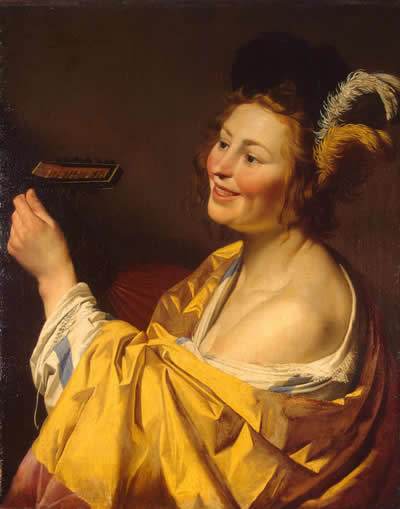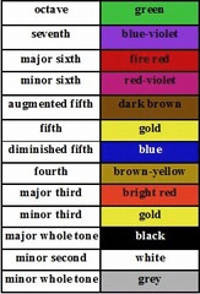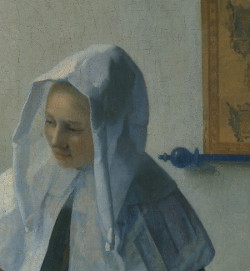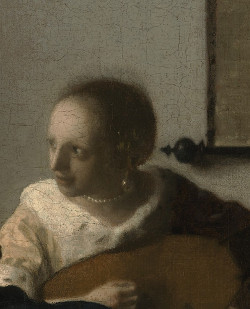Woman with a Lute
c. 1662–1665Oil on canvas
51.4 x 45.7 cm. (20 1/4 x 18 in.)
Metropolitan Museum of Art, New York
The picture is closely related in composition to Young Woman with a Water Pitcher but probably dates from slightly later, about 1662–1631. The arrangement of the table and silhouetted chair in the foreground, the use of a curtain, and the greater role of shadows suggest that Woman with a Lute was painted within a year or so of Woman with a Pearl Necklace and Woman with a Balance. The palette is also more muted than before. The overall effect, with strong contrasts of tone and blurred contours, is comparable to that of images formed in early camera obscuras. Nonetheless, the similar lighting schemes in De Hooch, Metsu, Van Mieris, and De Witte also made evocative use of broad, blending areas of shadow, reveal that, however extraordinary Vermeer's interest in optical effects may have been, he also responded to contemporary taste, which is evident from a survey of French and Flemish paintings as well as Dutch art.
Like the canvas from the Marquand Collection this one is traceable only from the early nineteenth century. The hypothesis is fraught with hazards, but one has the impression that several of the works Vermeer did not sell to his principal patron, Pieter van Ruijven, are generally more conventional in design and iconography. Here a worldly young woman, unrestrained by the map and other forms pressing in around her, glances eagerly out the window, as if expecting or even espying a dashing young man. The enormous pearl earring and the pearl necklace, which like the ermine-trimmed jacket were luxuries not worn every day identify the lady as a modern Venus in search of an Adonis or Mars. The viola da gamba on the floor and the flow of songbooks across the tabletop and onto the floor anticipate with some excitement the prospect of a duet. If tuning the lute hints at moderation, the thought seems appropriate, and consistent with the reminders of temperance in The Glass of Wine, Young Woman with a Wineglass, and Woman with a Balance.

Gerrit van Honthorst
1624
Oil on canvas, 84 x 67 cm.
The Hermitage, St Petersburg
The prominent placement of the chair in the foreground underscores the expectation of male companionship. The map may imply a man's absence, but Vermeer offers allusions rather than signs. In his obliquity the artist benefited from the contemporary viewer's familiarity with versions of the theme, which is found, for example, in Van Honthorsrt's pendant pictures of smiling sexpots, Woman Tuning a Lute (fig. 1) and Woman Playing a Guitar; which date from 1624 and by 1632 were in the Stadholder's Quarters in The Hague. Jan van Bronchorst's Woman Tuning a Theorbo (location unknown) and similarly seductive works by that Utrecht master and an endless stream of string-strumming strumpets in Italian, French, Flemish, and Dutch art (see Antiveduto Grarnrnatica's Young Woman Playing a Lute of about 1615–1620, in the Museo de Arte de Pance, Puerto Rico).
In about 1615 Hendrick van Steenwyck the Younger, a well-known figure at the Dutch and English courts, painted a patrician interior with a female lute player (fig. 2), a work that is typical of his native Antwerp in its remodeling of Italian prototypes and of obvious interest for Woman with a Lute and other musical subjects depicted by Vermeer. Here too, a viola da gamba, a manly instrument in stature and tone, rests on the near side of the table, which is strewn with songbooks and various instruments. The compositional similarities with the present picture and other works by Vermeer require no comment and clarify their place in a long tradition of fashionable genre scenes, especially those produced in the Spanish Netherlands and the southern parts of Holland. Far from being a contemplative picture—except for its study of light—the work would have been appreciated by its original owner for its dwelling upon lave and luxury, and for bringing him into association of with the sort of collectors who had owned such pictures before.

Hendrick van Steenwyck
the Younger
c. 1615
Oil on wood, 65 x 53 cm.
National Museum, Stockholm
The Map of Europe

Jennifer Henel
"Striking the Right Chord: Seeing Music in Dutch Genre Painting" - National Galleryof Art website
Cornelis Bloemaert
1665
Copper engraving print, 332 x 219 cm.
Collection
Germanisches Nationalmuseum, Nuremberg
For many in the seventeenth century, the question of balance [in painting] was not only visual, it was also aural. Indeed, during that time there was an awareness of and interest in a concept later named synesthesia, from the Greek syn (union) and aísthesis (sensation), meaning the union of the senses. Since the 4th century BC, theorists and philosophers, including Aristotle, have explored the link between color and sound, investigating the relationship between chromatic and musical tones.
These concepts were recognized and refined over the centuries by numerous scholars, including the seventeenth-century German Jesuit priest Athanasius Kircher (fig. 3), who, among other topics, wrote extensively on music theory. One of Kircher's most important theories was his work on the correspondence of musical notes to specific colors, which he coded into a chart and published in 1646 (fig. 4). According to Kircher, deep, dark sounds of minor notes are associated with cool, deep colors, while the warmer, brighter sounds of major notes are warmer, lighter colors. As a Jesuit priest, Kircher believed that the coexistence of sensory functions had profound implications in worship and that the immersion of sight and sound had the capacity, as one scholar wrote, to "move the passions, to produce strong emotional effects that, under properly controlled conditions, [could] ravish the soul and lead the faithful closer to the divine."
Kircher's articulation of the multisensory relationship between color and music resonates with Van Mander's advice for artists and suggests that the experience of looking at painting may engage viewers on a variety of sensory levels. For synesthetes, the integration of certain colors and shapes on an artist's panel or canvas may stimulate a musical experience, which would allow them to "hear" the painting."

Athanasius Kircher
1646.
For most viewers, a painting's composition reinforces the subject matter. In Vermeer's Woman with a Lute, for example, which is largely a cool, dark painting, accents of warm light on the upper left of the wall (promoted by whites and creams) direct our attention to the woman's face. Viewers are drawn in by the painting’s composition and color, while the lady tuning the lute provides the aural suggestion of harmony and balance.
A synesthete, however, might engage with this painting in a different way. The cool, dark tones present in the foreground could elicit a deep pitch, while the brighter colors on the back wall and in the face of the subject might produce warmer, major chords. Shapes also create aural associations: the diagonals of the tablecloth's edge and the curtain's shadow paired with the gently curving circles and ovals of the lute and the woman's face might create similar aural associations, perhaps sharp notes accompanied by a gentle major resolve (the movement from a dissonant sound to a consonant sound). Most synesthetes scan the progression of a painting like a musical score: from top to bottom, left to right. Here the work might open with a major chord in the far upper left, with the yellow from the daylight. Then, as the eye moves down through the diffused light of the wall to the darker registers, minor chords sound. The cool white of the elegant ermine trim on the woman's jacket could be a diminished chord, with the major resolve seen in the cream-and-gray marbled tile in the lower right.
Of the changes in Vermeer's style one is immediately apparent; hence forward each picture forms a broad and definite pattern of tone. Such a development is a common feature in a painter's evolution and in Vermeer's case it was no more than incidental to his search for the decisive tonal interval, the bare statement of light which, pursued in the detail of representation, constituted the baffling vocabulary of the last works. If, as may be imagined, he resorted to an optical device some contrast of tone would have been necessary for its use. Certainly the depth of tone in such pictures as the Lute Player is intimately connected with the profundity and completeness of his vision. His scheme, a sharp overlapping of dark on light and light on dark in alteration, is the irresistible pattern which Tintoretto had given to seventeenth-century painting; Vermeer was very familiar with it. But beside the comparatively meager version of it which is visible in the Soldier and Laughing Girl, it is clear that Vermeer's method, disengaging him from the claims of matter, now permits him an altogether more inclusive and confident hold, if not on life, at least on the mantle of light which half-reveals it. Hence forward, even when the contrasts involved are shallower, the lack of differentiation and the distribution of insignificant tonal incident which sometimes mark the earlier works are never seen again.

Gabriel Metsu
1659–1652
Museumlandschaft, Gemäldegalerie Alte Meister, Kassel
Vermeer's ladies who hold a lute or a guitar are not occupied with music-making. They turn away; there is some momentary distraction in the air to draw their attention. They are never discovered playing and they never confront us. The fact is of interest for it illustrates not only Vermeer's temperamental preference, his distaste for anything obtrusively purposeful or demonstrative in his subject, but also the way in which it governed his use of the resources of his school. The common role of such musicians in the work of his predecessors is as a victim of the perennial theme of interruption. Such is their usual role in the painting (fig. 5) of Haarlem and when wine is brought to one of Metsu's ladies she turns from her lute in precisely the attitude which Vermeer's sitter takes up. In one picture Vermeer supplies the intruder, the servant in The Love Letter; for the rest he produces a vestigial form of the motif, a scene of interruption from which the egregious cavaliers have long since been refined away, leaving only, in the lady's lateral glance, a reminiscence which is at once a tribute to tradition and an artifice to confine her lively nature within her own world.
A similar glance is the theme of the Woman with a Water Jug. Indeed there are several resemblances. The bobbin of the map-stick in each picture fits neatly with the nape of the girl's neck (fig. 6 & 7). In the Water Jug the contour of arm and hand is half-obscured, an arrangement naturally avoided by the conceptual draughtsman, and characteristic of Vermeer's freedom in this respect, which reaches an extreme in the Lute Player. In the design here a flavour of perversity lingers; it has an element of recapitulation. The stylistic solution is now within the painter's grasp but of this the Lute Player tells us nothing for the picture is a ruin and the original surface of paint has long disappeared.

Johannes Vermeer

Johannes Vermeer


